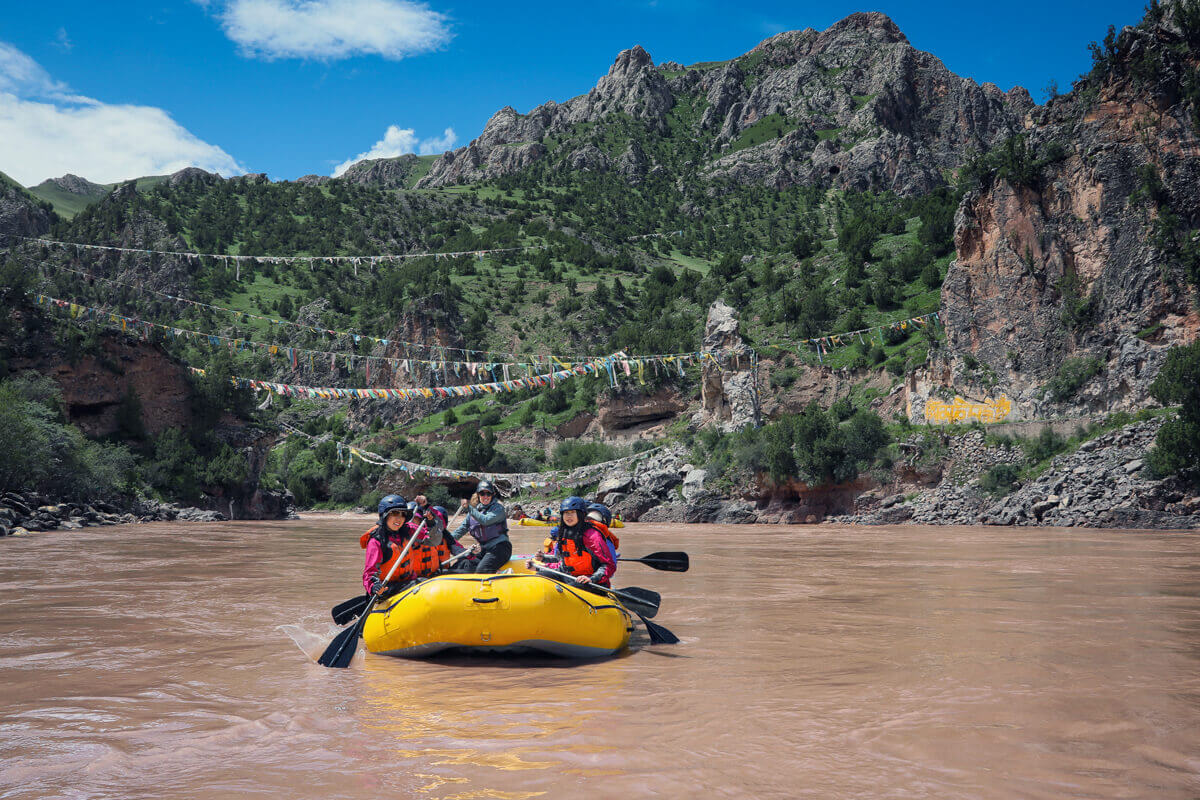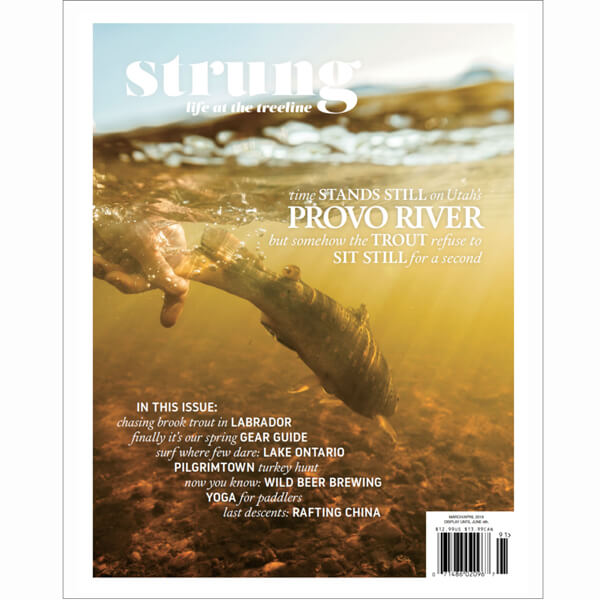Finding Daqu
By Meredith Meeks
Originally published in Strung Magazine #2 – Spring 2019
I woke up to small drops of water hitting my face. The night’s dew had condensed on the inside of my tent and was falling like a passing shower. My tent and sleeping bag were soaked through, leaving me cold and very awake. I looked at my watch. The sun wouldn’t come up for another two hours.
I was camped beside the Daqu River, headwaters of the Mekong, in China’s Qinghai Province. Our camp was on land allocated to Sanjiangyuan National Park, a “pilot” park scheduled to open in 2020. It was a shock to be here at all, let alone at the beginning of rafting season in a country with little established whitewater recreation culture. I came here as a video boater for Last Descents River Expeditions. Although multi-day rafting isn’t “a thing” in China, Last Descents aims to foster a whitewater community for the benefit of the Chinese people through exposure to their country’s vast wild areas.
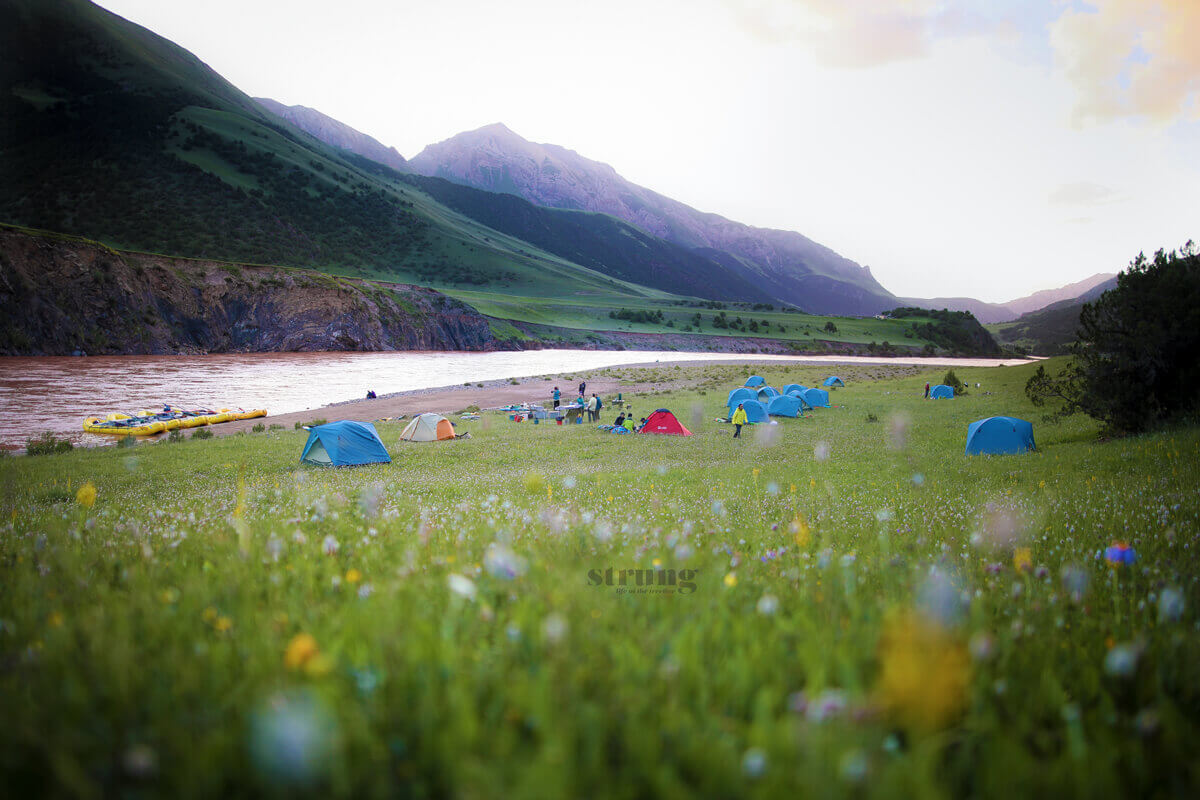
Sanjiangyuan means “Three Rivers Source Natural Reserve.” It is located in the Tibetan Autonomous Prefecture and contains the headwaters of Asia’s three great rivers: the Huang He, the Yangtze, and the Mekong. Somewhat confusingly, this region is separate from the popular conception of Tibet, known as the Tibet Autonomous Region of China, which lies roughly fifty miles away. China’s autonomous prefectures are a type of self-governing administrative division with ethnic minorities forming over fifty-percent of the population or being the historic home of significant minorities. Here, the majority of the population is Buddhist Tibetan. Once formalized, Sanjiangyuan National Park will consist of a third of the Sanjiangyuan region’s 76,490 square miles.
Deciding to make the most of my early morning, I stumbled out of my tent into the darkness. With camera in hand, I scrambled up towards a hill overlooking the river valley to catch the first sunrise of our trip. From my vantage I saw rolling green hills on the other side of the river, clouds curled over the edges of snow-capped peaks faintly traced in the distance. I pressed RECORD on my camera as the sun rose behind me. The river lit up bright and tangerine, its serpentine flow coursing through the valley. Our camp looked small from here but I could see people starting to emerge from their tents. Upstream, I noticed the brightly colored tents of a Tibetan nomadic camp. Downstream were hundreds of prayer flags strung across the river adjacent to a Buddhist monastery perched on the hillside.
I headed back to camp, descending on a cushion of green vegetation. The soft curves of the hills and meandering bends of the river were sharply dissected by the unnatural straightness of high voltage lines zapping and crackling above me, installed just one year ago. They felt misplaced among multitudes of wildflowers and the river’s thoughtless serenity. Farther downstream, where granite walls closed in, we would leave the power lines behind and experience a wild land only accessible by river.
 Last Descents River Expeditions was founded by Travis Winn in 2006. Winn originally came to China with his father, Peter, who was conducting geological research in the eighties and nineties and together they floated stretches of rivers that had never before seen hard-shells or rubber. Falling in love with China’s un-dammed rivers, Winn devoted himself to giving people the opportunity to experience them while they still ran unimpeded. When the dams on the Great Bend of the Yangtze were completed in 2012, Winn saw flowing waters which only a handful of people had ever rafted fall silent behind the seven large dams. It’s a loss he carries with him, and it has made him fight that much harder to protect China’s other great rivers. Exposing both young people and current decision makers to the value of free-flowing rivers became Winn’s primary way of trying to save them.
Last Descents River Expeditions was founded by Travis Winn in 2006. Winn originally came to China with his father, Peter, who was conducting geological research in the eighties and nineties and together they floated stretches of rivers that had never before seen hard-shells or rubber. Falling in love with China’s un-dammed rivers, Winn devoted himself to giving people the opportunity to experience them while they still ran unimpeded. When the dams on the Great Bend of the Yangtze were completed in 2012, Winn saw flowing waters which only a handful of people had ever rafted fall silent behind the seven large dams. It’s a loss he carries with him, and it has made him fight that much harder to protect China’s other great rivers. Exposing both young people and current decision makers to the value of free-flowing rivers became Winn’s primary way of trying to save them.
Like Winn, I believe that rivers have a profound effect upon us. They are immensely powerful with an uncanny ability to help us realize human impermanence. They help me tread more lightly and escape the ever-pervasive consumer headspace. The river is always changing and beyond my control. When I travel down a river, I must work with the water and respect the line that I have chosen. Nature shows us to be humble and respect our surroundings, if we pay attention.
I first found myself with Last Descents in January of 2018. I made five trips down the Salween, one of five major rivers in Yunnan Province, cutting through landscapes that didn’t exist in my wildest dreams. More often than not, the Salween was mired with trash as it flowed through populated valleys, past ancient temples, modern factories and farms. That winter, I learned just how threatened China’s rivers are. In Yunnan alone, 27 major dams are in various stages of planning or construction.
China’s rivers are being impounded at a rate unseen elsewhere in the world; currently, the country hosts 98,002 reservoirs, 46,758 hydropower stations, and 268,476 sluices with additional hydropower projects materializing every day.
I headed back to China in July 2018. After 48 hours of travel I landed in Yushu, Tibetan Autonomous Prefecture. With a population of 120,000 people, Yushu is barely a city in a country of 1.4 billion. Yushu sits at 12,100 feet, nestled between high mountains with prayer flags splayed on almost every summit. Here, the summer’s monsoon rains bring the majority of the moisture for the year, and July sees nearly-daily downpours. Once settled, we would be rowing 76 miles of the Daqu through the pilot park. Traveling through China, Myanmar, Laos, Thailand, Cambodia, and Vietnam, its 2,703 mile length is 1,253 miles greater than the Colorado River. It is truly one of the world’s great rivers.
The Sanjiangyuan region through which the Daqu flows is ethereal, with red rock gorges carved amongst vibrant grasslands replete with musk deer, Tibetan eared pheasants, and blue sheep grazing at the river’s edge; it is also one of the most densely populated and intact habitats for rarely-seen large carnivores that have been pushed out many other areas by human development. Many of the valleys are covered in a soft cushion of moss, lush green with pinnacles of granite reaching into the sky like bolts of lightning. The river most often appears as an opaque orange thread contrasted against rocks and carpets of vegetation. I had never seen anything like it. Because this area of Qinghai feeds the Huang He, Yangtze, and Mekong, all of which bear incredible continental importance, Sanjiangyuan has been proposed as China’s first national park. By showing an interest in resource and cultural preservation, Chinese decision makers are inciting a hopeful sea-change towards conservation-oriented land management practices. With any luck, Sanjiangyuan will be a model for future national parks.
While floating the Daqu, we had the opportunity to create a tutorial video to introduce the Chinese people to whitewater boating in their country. Winn and I decided that the best way to nudge local governments towards conservation action was to create a film that would persuade authorities that rafting is safe, environmentally-friendly, and bears profound educational value through intimate experience of the landscape. “Rafting 101” was to be a 15-minute tutorial that the new park could use to help guide visitors towards low-impact, high-stimulus visitation. No roads are needed to experience the landscape – the river serves that purpose and more.
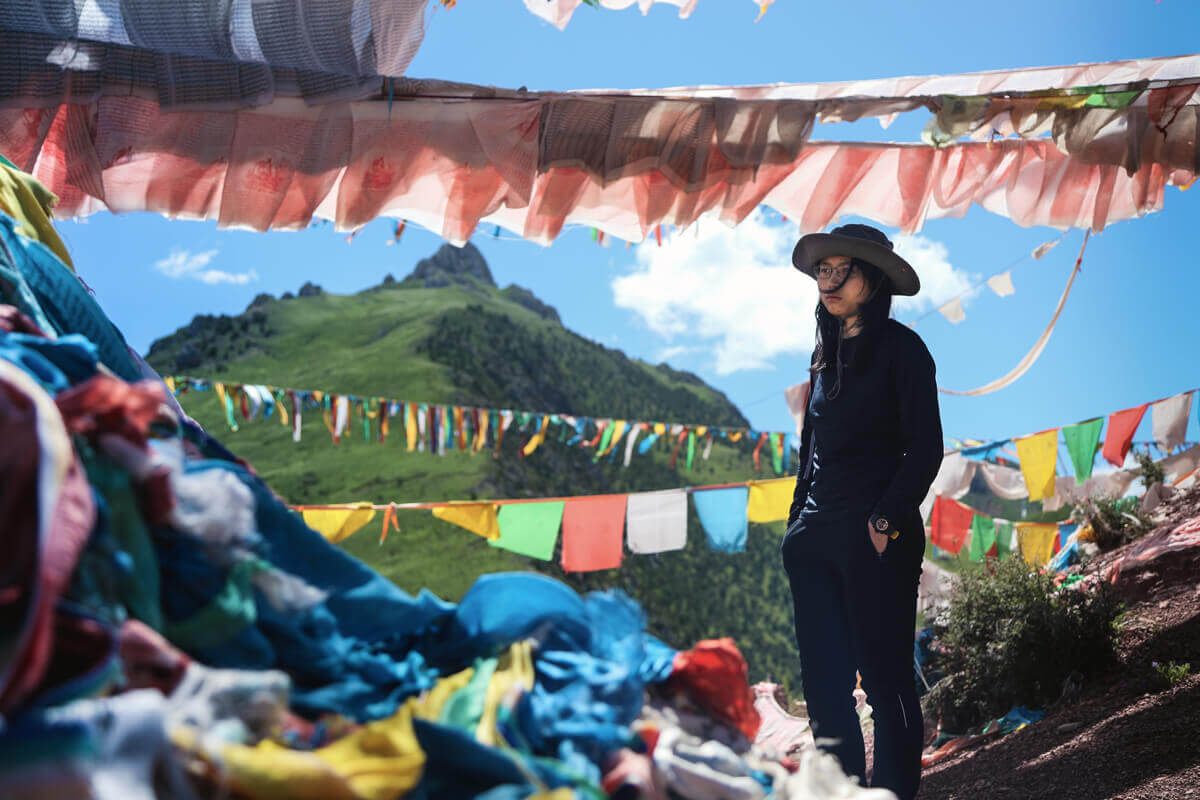
When I learned that nine local Tibetans ranging in age from 12 to 18 would be joining us, the film took on new meaning. I wanted to do something more substantial than just make trip videos for paying clients; I wanted to work with local residents to help preserve Sanjiangyuan. I wondered if they held similar thoughts and feelings about this place as I did. We were here at a critical time when the future of the park was being decided. At the time, I was not aware of how profound of an experience the trip would be and what I would learn along the way.
We launched the boats at nearly 13,000 feet, adjacent to a small town named Sahuteng. For all of my whitewater trips in China, rigging and launching has been the culmination of stress and nerves that invariably build in anticipation. Here, anything can happen. Working within the confines of Chinese bureaucracy, a permit may be granted one day while a different department or ministry demands a separate permit the next. Once on the water, the river had us in her grasp and we would move at her pace.
This particular eight-day trip was devoted to taking Sanjiangyuan’s first “Youth Rangers” down the river. Most of them grew up in Yushu with Sanjiangyuan in their backyard. These adolescents were chosen through an after school program called Pedkar Education, which aims to keep Tibetan culture alive through interactive cultural experiences. Th program was founded by Tsering “Diana” Pedkar, a Tibetan firecracker in her early forties, out of concern that cultural traditions were slowly dissipating with younger generations. She had formed an undeniable connection with each student on our trip and saw the benefit of incorporating curiosity and excitement into any learning experience.
The first few miles were silent as we catapulted back through time. I watched our young explorers, none of whom had never been on a raft, take it all in. Many people in China, especially Tibetans, don’t swim or have much of a recreational relationship with rivers. Namchen, our interpretation guide, explained to that “the source of rivers are always sacred because we believe all the living beings are using this water. Also, in our in culture, we believe that in the river there is a spiritual thing, the “naga,” which is almost like a powerful serpent that you don’t want to offend. Pollution to the environment or disrespectful acts such as washing soiled clothes in the river could result in naga afflictions.” He continued, “our parents didn’t let us play with the water. They didn’t let us swim in the river because they were afraid of the river. We don’t want to disrespect the mountain gods.”
At the beginning of each of our trips, fear was a constant for our passengers, who had little to no experience with boating or river recreation. As we started ticking off miles, the tension began to ease. The crew felt back in their natural environment: on the river with oars firmly in hand. The passengers gradually accepted that they weren’t going to drown unexpectedly. There was less fear of the water and more intrigue. The kids gained confidence and sat up front to greet the waves. Eventually, many of them wanted to be in charge of their inflatable kayak or stand-up paddle-board.
At the big rapids that required scouting, everyone would gather around Lao-Tang, our Renaissance man of a river guide, as he explained river hydraulics. Despite the language barrier, I could understand Lao-Tang perfectly. With theatrical gestures and diagrams made with sticks and rocks, he explained how we would work with the river while respecting the rapids. Every day was filled with educational moments about river sheds and the geological influence on Tibetan history engrained in this area. I watched as Lao-Tang instilled a sense of adventure and humility into the kids. The one-time lumberjack, truck driver, restaurant owner, baijiu drinker, and constant chain smoker had a way of keep everybody engaged, the crew included. With our days on the water slipping past, we found that the kids didn’t need to be pulled in or pandered to; they embraced this place wholeheartedly.
One day on the boat I sat next to Namchen, who was pointing out one of the mountains we were floating by to 12 year-old Pema “Macy” Seipa. Macy, small in stature, held his own with charisma, wit, and the group’s best dance moves. He was extremely aware of group dynamics and was always there for his friends, including me. I couldn’t understand what they were saying in Tibetan, but I could see that Macy was wrapping his head around some new ideas. Diana chimed in, her passion for helping Macy understand apparent. He smiled and nodded, squealing and pointing at the mountain further downstream. “Sacred mountain!”
As we meandered downstream, we saw nomadic families dancing alongside the river, waving and wishing us the best. There was less trash, less infrastructure, and more stares from shore at the circus of five 18-foot yellow rubber boats floating down the river. The concrete road next to us turned to gravel. The rapids grew larger while the gorge narrowed, opened up, and narrowed again. We rounded a bend and saw peaks stretching into the sky before plunging headlong into the riverbed. I wondered how long these rocks had been polished smooth. I looked at Macy and could see we were both taking in the enormity, one blink at a time. This was a place that defied urbanity and all of its trappings. It was a place – a feeling – to be protected.
At camp that night, I played soccer with the kids. I didn’t speak Chinese or Tibetan and felt awkward trying to socialize across age and cultural barriers. Unphased, Julia, an inviting 18 year-old, kicked the ball over to me, accepting me into the group. For the rest of the trip, we explored, laughed, and learned together. They taught me Tibetan phrases, laughed at my terrible accent, offered to carry my equipment, danced with me, and helped me not take my job too seriously. I watched these kids awaken to the river like I awoke as a child. I saw them opening to landscape. Their newfound knowledge seemed empowering.
Although excited at the prospect of introducing whitewater rafting to a new, unique group of people, a part of me was concerned by how scripted the film felt. “Welcome to Three Rivers Source National Park! A river trip through the Namsei core area is one of the most unique ways to experience the park and is guaranteed to be an experience that you will never forget! Remember to leave your cell phone and watch behind and come into this area with an open heart and mind, ready to accept the nature and culture here on its own terms! You will not regret it…” But the students were eager. They believed in the material and the mission. They wanted their government to know that the first Youth Rangers wanted this place to be protected.
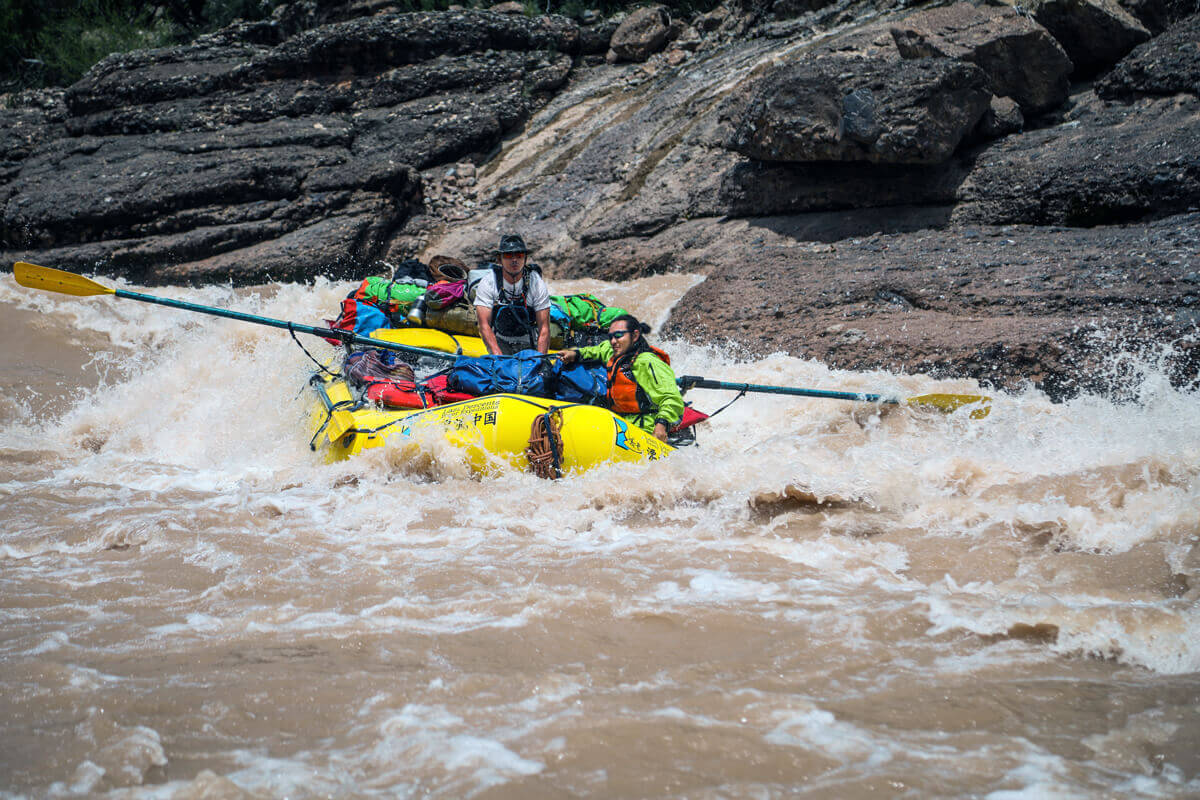
Sanjiangyuan exuded an air of holiness that I embraced. I walked clockwise around the mani stones etched with Tibetan mantras, just as the children did. These rocks covered in lichen spoke words of compassion. We would see mantras carved on rocks half-covered by water, on trails, in fields, and meditation caves. We came upon a shrine with tree-anchored prayer flags spiralling steeply to a pole at its center, creating a sort of steeple. I learned that this holy place had tripled in size over the past year and that the government was planning a bridge across the river here. Locals made it clear that the bridge wasn’t wanted. That type of development wasn’t needed here. The shrine signaled our departure from the park and back towards the city of Yushu.
As the trip wound down, one Tibetan boy, Tsering Pabar, realized that he had found something that he didn’t know he was looking for. “Our purpose was not just having fun. I learned the importance of humans’ connection with nature and the importance of environmental conversation. Usually when I travel to different places, I see roads and electric polls everywhere, but this time I saw so few of them… it was very pleasant to see just untouched nature. I realized that we really need to protect the environment and our homeland.” As I considered Tsering’s words, I walked clockwise around a collection of mani stones once and eventually towards the jutting granite cliffs with my camera strapped across me. I scrambled up the cliff’s flank to a precipice overlooking a bend in the river. I looked down at the river, wondering what this place will look like in five years. Will there be more power lines criss-crossing the valley, feeding restaurants, gift shops, and hotels? Will there be bumper-to-bumper traffic on paved roads that hug the river’s length? Or will it be much like it is now, wild and unspoiled? Which option is better for China and the Chinese people? We strive to connect the people of China with their rivers so they can decide what is important to them.
The development of Sanjiangyuan could go in several directions. It’s a future on the edge. I hope that Chinese decision makers listen to what these children are saying. One boy from Beijing, Sheng Xicheng, parted ways with this and it has resonated since: “This place brings you back to your original state, back to zero. Back to zero, your heart is open to learning about your true self. There are few natural rivers left. If these rivers disappear, there are few places to find ‘zero.’”

 Last Descents River Expeditions was founded by Travis Winn in 2006. Winn originally came to China with his father, Peter, who was conducting geological research in the eighties and nineties and together they floated stretches of rivers that had never before seen hard-shells or rubber. Falling in love with China’s un-dammed rivers, Winn devoted himself to giving people the opportunity to experience them while they still ran unimpeded. When the dams on the Great Bend of the Yangtze were completed in 2012, Winn saw flowing waters which only a handful of people had ever rafted fall silent behind the seven large dams. It’s a loss he carries with him, and it has made him fight that much harder to protect China’s other great rivers. Exposing both young people and current decision makers to the value of free-flowing rivers became Winn’s primary way of trying to save them.
Last Descents River Expeditions was founded by Travis Winn in 2006. Winn originally came to China with his father, Peter, who was conducting geological research in the eighties and nineties and together they floated stretches of rivers that had never before seen hard-shells or rubber. Falling in love with China’s un-dammed rivers, Winn devoted himself to giving people the opportunity to experience them while they still ran unimpeded. When the dams on the Great Bend of the Yangtze were completed in 2012, Winn saw flowing waters which only a handful of people had ever rafted fall silent behind the seven large dams. It’s a loss he carries with him, and it has made him fight that much harder to protect China’s other great rivers. Exposing both young people and current decision makers to the value of free-flowing rivers became Winn’s primary way of trying to save them.
